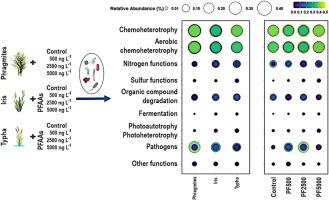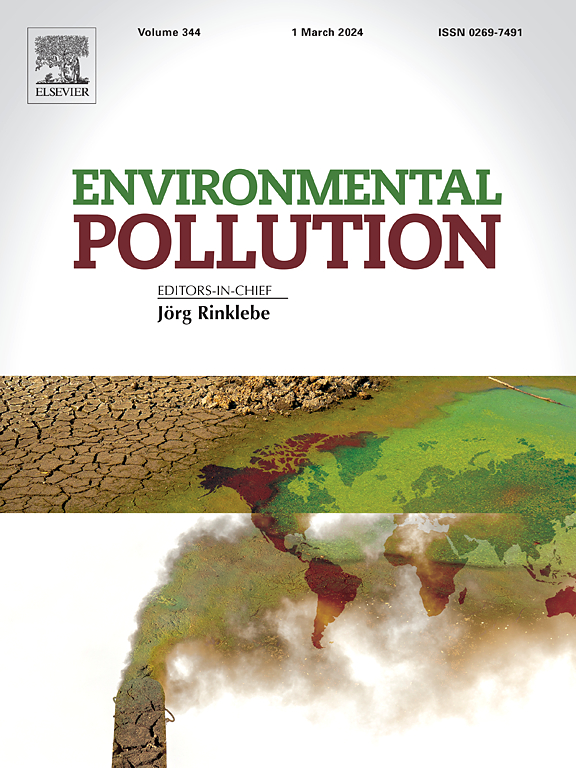植物物种对PFAAs在处理湿地细菌群落结构中的优势及其功能特征
IF 7.6
2区 环境科学与生态学
Q1 ENVIRONMENTAL SCIENCES
引用次数: 0
摘要
本研究探讨了不同植物种类(鸢尾、芦苇)对植物生长的影响。指标。Steud交货。)和含有不断增加的全氟烷基酸(PFAAs)浓度的溶液(11种全氟羧酸和3种全氟磺酸,每种浓度为500、2500和5000 ng L-1)对处理湿地(TW)生态系统中细菌群落的影响。目的是对植物物种和污染物浓度在形成选定细菌群落结构中的重要性进行排序。虽然微生物群落结构主要是植物物种的功能,但PFAAs对可预测的细菌功能谱有一定影响。在被测试的物种中,Typha在支持细菌群落方面表现出了特殊的多功能性,增强了氮、硫和有机化合物的代谢,优于鸢尾和芦苇。不同浓度的PFAA并未改变群落整体结构,但显著改变了单个功能基团的相对丰度。在分类上可预测的功能群中观察到的变化突出了PFAAs对特定植物细菌的影响,并且对其他特定化合物的代谢也有潜在的影响。该研究还确定了与特定植物物种相关的不同细菌功能概况,揭示了与Typha相关的细菌表现出更多的专门功能,而与芦苇相关的细菌则更符合通才类别。这表明,由于其支持有机化合物代谢的能力,Typha可能特别适合在富含pfa的废水中使用TWs。此外,研究结果表明,门多样性可以作为功能多样性模式的可靠代理。总体而言,本研究有助于揭示植物物种、PFAA浓度、细菌群落及其分解代谢功能之间的复杂关系,为优化处理湿地提供可开发的知识。本文章由计算机程序翻译,如有差异,请以英文原文为准。


Plant species dominance over PFAAs in structuring bacterial communities and their functional profiles in treatment wetlands
This study investigates the impact of different plant species (Iris pseudacorus L., Phragmites australis (Cav.) Trin. Ex Steud., Typha latifolia L.) and solutions containing increasing perfluoroalkyl acids (PFAAs) concentrations (11 perfluorocarboxylic acids and three perfluorosulfonic acids, 500, 2500, and 5000 ng L−1, each) on bacterial communities in treatment wetland (TW) mesocosm systems. The aim was to rank the respective importance of plant species and pollutant concentration in shaping the structure of the selected bacterial communities. While microbial community structure was mainly a function of plant species, PFAAs had some effect on the predictable bacterial functional profiles. Among the tested species, Typha demonstrated exceptional versatility in supporting bacterial communities with enhanced nitrogen, sulfur, and organic compound metabolism, outperforming Iris and Phragmites. Different PFAA concentrations did not modify the overall taxonomical community structure, although they significantly altered the relative abundances of single functional groups. The observed variations in taxonomy-predictable functional groups highlighted the impact of PFAAs on specific plant bacteria, with potential implications also for the metabolism of other specific compounds. The study also identified distinct bacterial functional profiles associated with specific plant species, revealing that bacteria linked to Typha exhibited more specialized functions, while those associated with Phragmites qualified more within the generalist category. This suggests that Typha may be particularly suitable for TWs under PFAA-rich wastewaters, due to its ability to support the metabolism of organic compounds. Additionally, results indicated that phylum diversity may be used as a reliable proxy of functional diversity patterns. Overall, this study contributes to cast light on the intricate relationships between plant species, PFAA concentrations, and bacterial communities and their catabolic functions, which provides an exploitable advancement of knowledge for the optimization of treatment wetlands.
求助全文
通过发布文献求助,成功后即可免费获取论文全文。
去求助
来源期刊

Environmental Pollution
环境科学-环境科学
CiteScore
16.00
自引率
6.70%
发文量
2082
审稿时长
2.9 months
期刊介绍:
Environmental Pollution is an international peer-reviewed journal that publishes high-quality research papers and review articles covering all aspects of environmental pollution and its impacts on ecosystems and human health.
Subject areas include, but are not limited to:
• Sources and occurrences of pollutants that are clearly defined and measured in environmental compartments, food and food-related items, and human bodies;
• Interlinks between contaminant exposure and biological, ecological, and human health effects, including those of climate change;
• Contaminants of emerging concerns (including but not limited to antibiotic resistant microorganisms or genes, microplastics/nanoplastics, electronic wastes, light, and noise) and/or their biological, ecological, or human health effects;
• Laboratory and field studies on the remediation/mitigation of environmental pollution via new techniques and with clear links to biological, ecological, or human health effects;
• Modeling of pollution processes, patterns, or trends that is of clear environmental and/or human health interest;
• New techniques that measure and examine environmental occurrences, transport, behavior, and effects of pollutants within the environment or the laboratory, provided that they can be clearly used to address problems within regional or global environmental compartments.
 求助内容:
求助内容: 应助结果提醒方式:
应助结果提醒方式:


